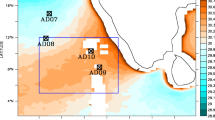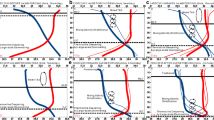Abstract
The barrier layer (BL) — a salinity stratification embedded in the upper warm layer — is a common feature of the tropical oceans. In the northern Indian Ocean, it has the potential to significantly alter the air–sea interactions. In the present paper, we investigate the spatio-temporal structure of BL in the Arabian Sea during summer monsoon. This season is indeed a key component of the Asian climate. Based on a comprehensive dataset of Conductivity–Temperature–Depth (CTD) and Argo in situ hydrographic profiles, we find that a BL exists in the central Arabian Sea during summer. However, it is highly heterogeneous in space, and intermittent, with scales of about ∼100 km or less and a couple of weeks. The BL patterns appear to be closely associated to the salinity front separating two water masses (Arabian Sea High Salinity Water in the Northern and Eastern part of the basin, fresher Bay of Bengal Water to the south and to the west). An ocean general circulation model is used to infer the formation mechanism of the BL. It appears that thick (more than 40 m) BL patterns are formed at the salinity front by subduction of the saltier water mass under the fresher one in an area of relatively uniform temperature. Those thick BL events, with variable position and timing, result in a broader envelope of thinner BL in climatological conditions. However, the individual patterns of BL are probably too much short-lived to significantly affect the monsoonal air–sea interactions.









Similar content being viewed by others
References
Agarwal N et al (2012) Argo observations of barrier layer in the tropical Indian Ocean. J Adv Space Res. doi:10.1016/j.asr.2012.05.021
Antonov JI, Locarnini RA, Boyer TP, Mishonov AV, Garcia HE (2006) In: Levitus S (ed) World ocean atlas 2005, Volume 2: Salinity. NOAA Atlas NESDIS 62, U.S. Government Printing Office, Washington, D.C, 182 pp
Arakawa A (1966) Computational design for long term numerical integration of the equations of fluid motion, two dimensional incompressible flow. Part I. J Comput Phys I:119–149
Blanke B, Delecluse P (1993) Variability of the tropical Atlantic Ocean simulated by a general circulation model with two different mixed layer physics. J Phys Oceanogr 23:1363–1388
Blanke B, Raynaud S (1997) Kinematics of the Pacific Equatorial Undercurrent: an Eulerian and Lagrangian approach for GCM results. J Phys Oceanogr 27:1038–1053
Blanke B, Arhan M, Madec G, Roche S (1999) Warm water paths in the equatorial Atlantic as diagnosed with a general circulation model. J Phys Oceanogr 29:2753–2768
Boyer TP, Antonov JI, Baranova OK, Garcia HE, Johnson DR, Locarnini RA, Mishonov AV, O’Brien TD, Seidov D, Smolyar IV, Zweng MM (2009) World ocean database 2009. In: Levitus S (ed) NOAA atlas NESDIS 66. U.S. Gov. Printing Office, Wash., D.C., pp 216, DVDs
Chatterjee A, Shankar D, Shenoi SSC, Reddy GV, Michael GS, Ravichandran M, Gopalakrishna VV, Rama Rao EP, Udaya Bhaskar TVS, Sanjeevan VN (2012) A new atlas of temperature and salinity for the North Indian Ocean. J Earth Syst Sci 121(3):559–593
Cronin MF, McPhaden MJ (2002) Barrier layer formation during westerly wind bursts. J Geophys Res 107(C12):8020. doi:10.1029/2001JC001171
de Boyer Montégut C, Madec G, Fischer AS, Lazar A, Iudicone D (2004) Mixed layer depth over the global ocean: an examination of profile data and a profile-based climatology. J Geophys Res 109, C12003. doi:10.1029/2004JC002378
de Boyer Montégut C, Mignot J, Lazar A, Cravatte S (2007a) Control of salinity on the mixed layer depth in the world ocean: 1. General description. J Geophys Res 112, C06011. doi:10.1029/2006JC003953
de Boyer Montégut C, Vialard J, Shenoi SSC, Shankar D, Durand F, Ethé C, Madec G (2007b) Simulated seasonal and interannual variability of mixed layer heat budget in the north Indian Ocean. J Clim 20:3249–3268. doi:10.1175/JCLI4148.1
Durand F, Shankar D, de Boyer Montégut C, Shenoi SSC, Blanke B, Madec G (2007) Modeling the barrier-layer formation in the South-Eastern Arabian Sea. J Clim 20(10):2109–2120. doi:10.1175/JCLI4112.1
Durand F, Alory G, Dussin R, Reul N (2013) SMOS reveals the signature of Indian Ocean Dipole events. Ocean Dyn. doi:10.1007/s10236-013-0660-y
Esenkov OE, Olson DB, Bleck R (2003) A study of the circulation and salinity budget of the Arabian Sea with an isopycnic coordinate ocean model. Deep-Sea Res II 50:2091–2110
Goosse H, Campin JM, Deleersnijder E, Fichefet T, Mathieu PP, Maqueda AAM, Tartinville B (2001) Description of the CLIO model version 3.0. Institut d’Astronomie et de Géophysique Georges Lemaitre, Catholic University of Louvain, Belgium
Hoyos CD, Webster PJ (2007) The role of intraseasonal variability in the nature of Asian monsoon precipitation. J Clim 20(17):4402–4424
Locarnini RA, Mishonov AV, Antonov JI, Boyer TP, Garcia HE (2006) In: Levitus S (ed) World ocean atlas 2005, Volume 1: Temperature. NOAA Atlas NESDIS 61, U.S. Government Printing Office, Washington, D.C, 182 pp
Lukas R, Lindstrom E (1991) The mixed layer of the western equatorial Pacific Ocean. J Geophys Res 96(Suppl):3343–3358
Madec G (2008) NEMO reference manual, ocean dynamics component. Note du pôle de modélisation, IPSL France N°27 ISSN N°1288-1619
Maes C, Picaut J, Belamari S (2005) Importance of salinity barrier layer for the buildup of El Niño. J Clim 18:104–118
Masson S, Luo JJ, Madec G, Vialard J, Durand F, Gualdi S, Guilyardi E, Behera S, Delecluse P, Navarra A, Yamagata T (2005) Impact of barrier layer on winter–spring variability of the South-Eastern Arabian Sea. Geophys Res Lett 32, L07703. doi:10.1029/2004GL021980
Mignot J, de Boyer Montégut C, Lazar A, Cravatte S (2007) Control of salinity on the mixed layer depth in the world ocean: 2. Tropical areas. J Geophys Res 112, C10010. doi:10.1029/2006JC003954
Mignot J, de Boyer Montégut C, Tomczak M (2009) On the porosity of barrier layers. Ocean Sci 5:379–387. doi:10.5194/os-5-379-2009
Prasad TG, Ikeda M (2002) A numerical study of the seasonal variability of Arabian Sea high-salinity water. J Geophys Res 107(C11):3197. doi:10.1029/2001JC001139
Prasanna Kumar S, Prasad TG (1999) Formation and spreading of Arabian Sea high salinity water mass. J Geophys Res 104(C1):1455–1464
Price JF (1979) Observations of a rain-formed mixed layer. J Phys Oceanogr 9:643–649
Rao RR, Sivakumar R (2003) Seasonal variability of sea surface salinity and salt budget of the mixed layer of the north Indian Ocean. J Geophys Res 108:3009. doi:10.1029/2001JC000907
Roemmich D, Gilson J (2009) The 2004–2008 mean and annual cycle of temperature, salinity, and steric height in the global ocean from the Argo Program. Progr Oceanogr 82:81–100
Thadathil P, Thoppil P, Rao RR, Muraleedharan PM, Somayaju YK, Gopalakrishna VV, Murthugudde R, Reddy GV, Revichandran C (2008) Seasonal variability of the observed barrier layer in the Arabian Sea. J Phys Oceanogr 38:624–638
Tomczak M (1999) Some historical, theoretical and applied aspects of quantitative water mass analysis. J Mar Res 57:275–303
Troupin C, Barth A, Sirjacobs D, Ouberdous M, Brankart J-M, Brasseur P, Rixen M, Alvera Azcarate A, Belounis M, Capet A, Lenartz F, Toussaint M-E, Beckers J-M (2012) Generation of analysis and consistent error fields using the Data Interpolating Variational Analysis (Diva). Ocean Model 52–53:90–101
Vialard J, Delecluse P (1998) An OGCM study for the TOGA decade: part II. Barrier layer formation and variability. J Phys Oceanogr 28:1089–1106
Wirth A, Willebrand J, Schott F (2002) Variability of the Great Whirl from observations and models. Deep-Sea Res II 49:1279–1295
You Y (1998) Rain-formed barrier layer of the western equatorial Pacific warmpool: a case study. J Geophys Res 103(C3):5361–5378
Acknowledgements
This study was funded by IRD, IFREMER, Mercator Océan and CNRS. Support from these institutions is gratefully acknowledged. We are indebted to the people who set up the International ARGO Project and made the ARGO dataset freely available. The model simulations were performed on a SGI computer. We made extensive use of the SAXO software (http://forge.ipsl.jussieu.fr/saxo) developed by Sébastien Masson for plotting. We appreciated constructive comments by Gurvan Madec.
Author information
Authors and Affiliations
Corresponding author
Additional information
Responsible Editor: Eric Deleersnijder
Electronic supplementary material
Below is the link to the electronic supplementary material.
Fig. S1
Seasonal evolution of the surface salinity observed in the climatology of Chatterjee et al. (2012) (left) and simulated by the model (right). The tri-monthly seasons are indicated on each frame (DOCX 1365 kb)
Fig. S2
Monthly distribution of observed salinity at 10 m (left column) and observed BLT (right column) for (from top to bottom) July 2006, August 2006, July 2007, August 2007, July 2008, August 2008. The dotted line, linking together the neighbouring profiles with salinity lying between 35.8 and 36.2 psu, is a proxy for the position of the salinity front between ASHSW and BBW. It is drawn both on the salinity and the BLT plots (DOCX 2053 kb)
Rights and permissions
About this article
Cite this article
de Boyer Montégut, C., Durand, F., Bourdallé-Badie, R. et al. Role of fronts in the formation of Arabian Sea barrier layers during summer monsoon. Ocean Dynamics 64, 809–822 (2014). https://doi.org/10.1007/s10236-014-0716-7
Received:
Accepted:
Published:
Issue Date:
DOI: https://doi.org/10.1007/s10236-014-0716-7




